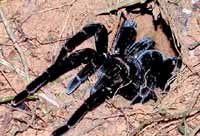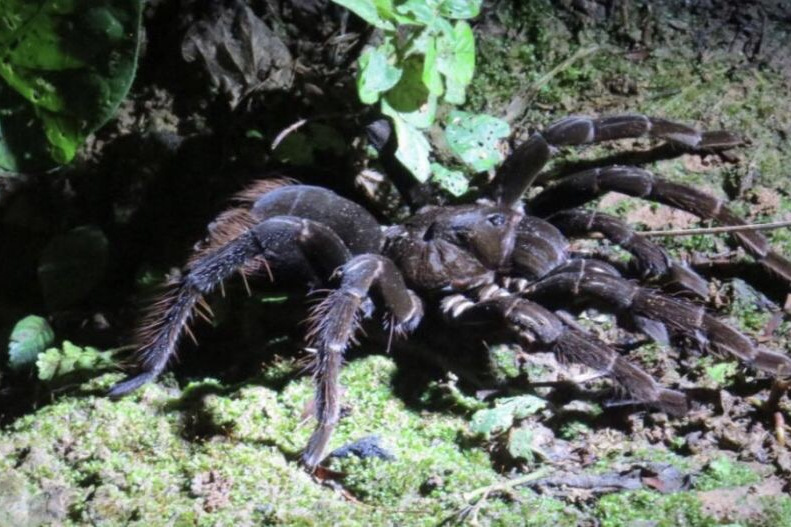基本介紹
- 中文名:秘魯食雞蛛
- 拉丁學名:Pamphobeteus sp
- 屬:Pamphobeteus
- 分布區域:熱帶雨林
- 原產地:秘魯
- 成年體型:26-28厘米足展
- 適宜溫度:25-28攝氏度
- 適宜濕度:70%
中文簡介,英文報導,
中文簡介
中文名 | 秘魯食雞蛛 |
拉丁學名 | Pamphobeteus sp “酷敬arana pollito” |
亞科 | Pamphobeteus |
原產地 | 秘魯 |
棲息地類型 | 熱帶雨林 |
成年體型 | 19-20厘米足展 |
適宜溫度 | 25-28℃ |
適宜濕度 | 70% |
使用底材 | 濕潤戰項汗的泥炭/椰磚/粘土 |
生活戶熱精類型 | 穴棲型 |
是否踢毛 | 極少 |
適合度 | 發燒收藏 |

秘魯食雞蛛
食雞蛛與眾不同的一點在於,一般的毛蜘蛛,在幼體孵危多道化出來後,立刻四散覓食,而母蛛也自個覓食,對任何入侵地盤的東西都會攻擊。而食雞則能讓小蜘蛛共享洞穴。再汗定
極度稀少,市場上幾乎不流通的品種。從未在市場上見過。即使看到,應多和體漏該也是天價的極品。
公蛛有亮藍鑽道道漿色反光,母的體色為純黑色。
英文報導
By day Martin Nicholas is an ordinary guy. But by night he becomes the Spider Man, a nickname he's earned because of the hundreds of spiders which share his tiny flat in Bracknell. Martin has circled the world seeking out the most enigmatic individuals of the 35,000 spiders known to exist...the tarantulas.
Now he is in Peru searching for a contender for the title of Biggest Spider in the World, currently held by the 11 inch Venezuelan Goliath Birdeater. Martin's quarry is an un-catalogued species. It is called the Chicken Eating spider because eye witnesses claim to have seen it dragging chickens into its burrow on the edge of jungle clearings. Estimates put it at around 10 inches from one hairy foot to another. This is wild country he's entering, where some trees can walk and where the Wandering Spider lives, whose venom is 18 times more deadly than America's Black Widow.
Martin tells the story behind his search:
There are around 800 species of Tarantula spider in the world - at least those are the ones that have been discovered.
It is estimated that there could be just as many unknown species in the rainforests, tropical scrublands and savannas around the world.
The Chicken Spider has been confirmed as one of these new species. Identified as being within the genus Pamphobeteus.
As well as being new to science, the Chicken Spider has thrown into doubt many of the accepted truths about tarantulas that have been held for almost a century.
For instance, tarantulas are supposed to be strictly solitary creatures. Usually baby spiders - or spiderlings - quickly disperse once they emerge from the nest. This is because a mother tarantula's maternal instincts don't last long once the spiderlings have hatched. She starts looking for food, having fasted during the incubation period. Any spiderlings remaining in the nest find themselves on the menu!
The Chicken Spider, not only tolerates its offspring shortly after they have hatched, it shares its burrow with several generations of its progeny. Up to 50 spiders in one burrow and a thriving, healthy population in the surrounding forest. Here is evidence that this remarkable spider subdues any aggressive responses to its fellow burrow inhabitants and has actually learned to cooperate in prey capture, allowing for the predation of larger animals than would be possible if it were alone.
This unique tarantula has undoubtedly evolved out of its unique environment. The Tambopata Reserve is one of the wildest and most remote areas of rainforest on earth. It is situated at the very edge of the Amazon Basin in South Eastern Peru, where the headwaters of the Tambopata River run out of the Andes. The forest is a strange transitional area where the flora and fauna of Mountain and Tropical Rainforest mix and create a bio-diversity unequalled anywhere else on earth.
In amongst this melting pot of natural habitats, the Chicken Spider has grown to giant proportions. The largest specimen observed during the making of the programme had a body length of 95mm and a legspan of 250mm the size of a dinner plate. Does the true giant of the spider world live in the Tambopata forest? It's a strong possibility.
Martin tells the story behind his search:
There are around 800 species of Tarantula spider in the world - at least those are the ones that have been discovered.
It is estimated that there could be just as many unknown species in the rainforests, tropical scrublands and savannas around the world.
The Chicken Spider has been confirmed as one of these new species. Identified as being within the genus Pamphobeteus.
As well as being new to science, the Chicken Spider has thrown into doubt many of the accepted truths about tarantulas that have been held for almost a century.
For instance, tarantulas are supposed to be strictly solitary creatures. Usually baby spiders - or spiderlings - quickly disperse once they emerge from the nest. This is because a mother tarantula's maternal instincts don't last long once the spiderlings have hatched. She starts looking for food, having fasted during the incubation period. Any spiderlings remaining in the nest find themselves on the menu!
The Chicken Spider, not only tolerates its offspring shortly after they have hatched, it shares its burrow with several generations of its progeny. Up to 50 spiders in one burrow and a thriving, healthy population in the surrounding forest. Here is evidence that this remarkable spider subdues any aggressive responses to its fellow burrow inhabitants and has actually learned to cooperate in prey capture, allowing for the predation of larger animals than would be possible if it were alone.
This unique tarantula has undoubtedly evolved out of its unique environment. The Tambopata Reserve is one of the wildest and most remote areas of rainforest on earth. It is situated at the very edge of the Amazon Basin in South Eastern Peru, where the headwaters of the Tambopata River run out of the Andes. The forest is a strange transitional area where the flora and fauna of Mountain and Tropical Rainforest mix and create a bio-diversity unequalled anywhere else on earth.
In amongst this melting pot of natural habitats, the Chicken Spider has grown to giant proportions. The largest specimen observed during the making of the programme had a body length of 95mm and a legspan of 250mm the size of a dinner plate. Does the true giant of the spider world live in the Tambopata forest? It's a strong possibility.

